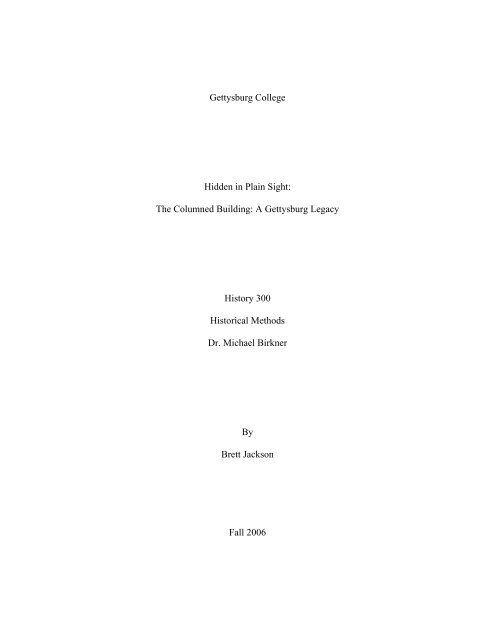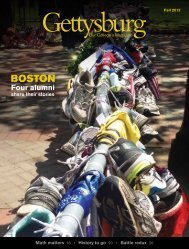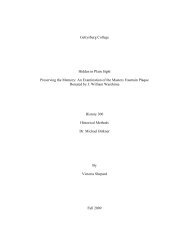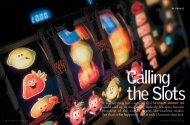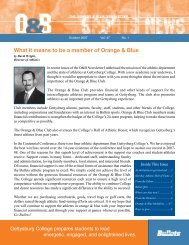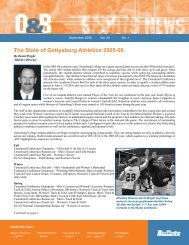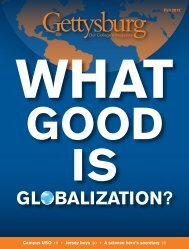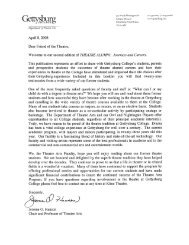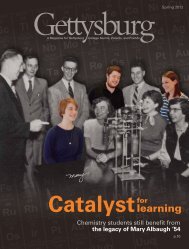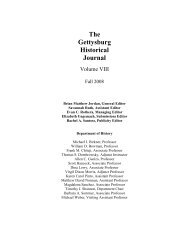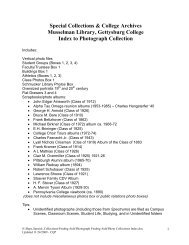157 North Washington Street Paper - Gettysburg College
157 North Washington Street Paper - Gettysburg College
157 North Washington Street Paper - Gettysburg College
Create successful ePaper yourself
Turn your PDF publications into a flip-book with our unique Google optimized e-Paper software.
<strong>Gettysburg</strong> <strong>College</strong><br />
Hidden in Plain Sight:<br />
The Columned Building: A <strong>Gettysburg</strong> Legacy<br />
History 300<br />
Historical Methods<br />
Dr. Michael Birkner<br />
By<br />
Brett Jackson<br />
Fall 2006
A new Eisenhower Institute for Leadership and Public Policy is currently being installed<br />
at <strong>157</strong> <strong>North</strong> <strong>Washington</strong> <strong>Street</strong>, the house which was home to a young Dwight Eisenhower and<br />
his family during the summer of 1918. Eisenhower became a longtime friend of <strong>Gettysburg</strong><br />
<strong>College</strong>, and as President Katherine Haley Will states, “We claim Ike as our own.” 1 However, a<br />
summer rental by a future national hero does not fully capture the historical value of this<br />
residence to our campus. In fact, it was owned for over forty years by Alpha Tau Omega and its<br />
story traces the birth of the <strong>College</strong> fraternity scene while also providing a detailed illustration of<br />
campus life during World War II. If you walk <strong>North</strong> <strong>Washington</strong> <strong>Street</strong>, you may pass the<br />
historic house without a glance, but, as was my experience, once you stare straight at its<br />
imposing white columns, you sense its import.<br />
Alpha Upsilon, the <strong>Gettysburg</strong> chapter of Alpha Tau Omega was chartered in 1882, two<br />
years after its northern inception at the University of Pennsylvania, as the sixth fraternity to come<br />
to campus. ATO was the first national fraternity established after the Civil War, and as one of the<br />
first charters above the Mason Dixon Line, <strong>Gettysburg</strong>’s Alpha Upsilon represented a northern<br />
attempt to fulfill “the spiritual reunion of the nation,” 2 by nurturing a brotherhood which would<br />
“unite fraternally the young men of the south with those of the north in permanent peace,” 3 on<br />
the very battlefield whose name rang of national division and bloodshed. C.W. Baker became<br />
Pennsylvania <strong>College</strong>’s first initiated brother, prompting the chapter to “immediately become<br />
active in fraternity matters,” with the publication of Alpha Tau Omega’s national magazine from<br />
1882-1888, The Palm, and the compiling of the premier ATO Song book. 4 The chapter<br />
organized despite <strong>College</strong> opposition to fraternities, which viewed them as subversive groups<br />
which threatened order by maintaining secrecy. 5<br />
2
The <strong>College</strong>’s antagonism of the emerging fraternal scene began to soften after the<br />
<strong>College</strong> Monthly in 1887 ran quotes from Andrew White, then President of Cornell University,<br />
in which he defended the secret societies by employing a logic which Glatfelter explains as,<br />
“Wipe out the fraternities and some other “cliques, clubs, parties, and intrigues” will take their<br />
place.” 6 The <strong>College</strong> subsequently allowed one or two members of each fraternity to attend their<br />
national convention, yet maintained only a vague catalogue reference to “Greek letter societies”<br />
which had begun to build meeting houses on campus. 7 These meeting houses became essential as<br />
rising membership in each fraternity made the confines of a member’s dorm room a less than<br />
ideal arena for chapter meetings. Indeed, the <strong>College</strong> Spectrum of 1899 estimated that 417 out of<br />
a graduated total of 1,068 men had been members of a fraternity. This 39% Greek campus of<br />
over a century ago nearly rivals the 2005 <strong>College</strong> statistics of a 43% Greek rate and demonstrates<br />
the need which initiated the construction chapter houses. 8<br />
It was out of this need that in 1904, ATO followed four other fraternities and laid the<br />
cornerstone for its chapter house on <strong>North</strong> <strong>Washington</strong> <strong>Street</strong> on a lot it had purchased for $7500<br />
from a local real estate entrepreneur. 9 As Glatfelter states, by 1904 fraternities “had won their<br />
battle for recognition and were already establishing themselves as formidable centers of student<br />
power and alumni loyalty.” 10 Accordingly, fraternity chapter houses, which had been one story<br />
structures consisting of one or two meeting rooms, began to be replaced by the construction of<br />
dormitories in which “with faculty and trustee permission, members ate, slept, and otherwise<br />
lived together.” 11 The original ATO house, located directly across from what was the college’s<br />
main entrance, was as Elwood Christ describes it in the building’s Historical Resource Survey<br />
Form, was a “three-story, brick, Sullivanesque styled structure. The first story porch, recessed<br />
under the upper stories was accented by ogee or flattened gothic arches . . . the front of the roof .<br />
3
. . included the letters ATO. 12 This dormitory style house was the fraternity’s first permanent<br />
stake around the college campus and was the base from which Bob Fortenbaugh Sr, class of<br />
1913, and future ATO National Vice President, along with the first graduating classes of the<br />
fraternity would develop and promote its brotherhood. 13<br />
When the entire house burned to the ground around 1:30 am February 22, 1914, the<br />
<strong>Gettysburg</strong>ian would lament that the brick structure was “practically new and modern in every<br />
respect,” the fitting home of a fraternity said to be “in a very prosperous condition.” 14 Everything<br />
in the house was reduced to ash, including the totality of the fraternity records. Only the four<br />
walls remained. 15 Sebastian Hafer recounted a story that Bill Hutchinson, who he said was “quite<br />
the sportsman,” had used a high power gun to try and make a wall topple. 16 While the fire was<br />
an enormous loss for the brotherhood, it was completely covered by insurance and ATO rebuilt<br />
immediately upon the same foundation. 17 The new $20,000 structure was dedicated in on April<br />
15, 1915, and its unveiling during Commencement Week was commemorated with the printing<br />
of brown programs which included a short chapter history and pictures of the old house, new<br />
house, and the current chapter members. 18 This program reveals the pride Alpha Tau Omegas<br />
had in the resurrected house and the optimism they held for their future saying:<br />
Our new home is truly a memorial to Alpha Tau Omega and that means every one of us .<br />
. . the noble monument which stands as a Phoenix on the ashes of the old house is a<br />
fitting tribute to our beloved fraternity. Fine as it is in appearance its true worth is rather<br />
the fact that it is a memorial to our brotherhood bought with the true spirit of devotion at<br />
the cost of much hard cash from many of us and many hard hands for the active men of<br />
the chapter of 1914-1915. 19<br />
The members exalted the fact that their chapter now had twenty-one members, the most<br />
numerousATO had been at <strong>Gettysburg</strong>, declaring, “that it should stand among the best with<br />
nothing to offer for the great part of the year shows a true grasp of the ideals of the fraternity.”<br />
They enjoined their alumni to return saying, “You can only appreciate the prominence and honor<br />
4
which Alpha Tau Omega now enjoys and will continue to enjoy by coming back and seeing for<br />
yourself.” 20 Indeed, ATO and the other fraternities were growing in campus prominence as<br />
evidenced by the fact that the <strong>College</strong> President, Dr. W.A. Granville spoke at the house<br />
dedication, followed by a performance of the <strong>College</strong> orchestra. The house from which he spoke,<br />
still stands today, and is an architecturally impressive neoclassical structure, with imposing<br />
columns which dominate the surrounding buildings. 21 Robert Fortenbaugh Jr., an ATO of the<br />
class of 1944 said, “that interesting front porch is what distinguished it,” 22 and although its<br />
future longtime owner Sebastian Hafer personally liked the first structure, he admits, “this one is<br />
more striking. 23<br />
It was perhaps the prominent nature of the building that enticed Dwight and Mamie<br />
Eisenhower to rent the fraternity house in May of 1918. Mamie had grown up in a wealthy<br />
family and was accustomed to elegant homes, while <strong>Gettysburg</strong>’s Camp Colt was Ike’s first<br />
substantial command position since graduating from West Point. When their rented apartment,<br />
on the second floor of Ma Hutchinson’s General Store proved unsuitable to Mamie, who had to<br />
walk through the store to enter the primitive space, the college provided the couple with the<br />
empty fraternity house. 24 As Elwood Christ said in interview, Ma’s old store is now “Kollege<br />
Korner,” and the storefront is still visible. According to Mr. Hafer, while the Eisenhower Society<br />
created markers for each of the three WWI Eisenhower residences, a marker has yet to be placed<br />
on the store. 25 As Mr. Hafer said, before renting the ATO house, the Eisenhower’s had “moved<br />
from Army billet to Army billet,” making the frat house Mamie’s first home. 26 In his book Red<br />
Carpet for Mamie, Alden Hatch incorrectly identifies their main <strong>Gettysburg</strong> house as one on<br />
Springs Avenue which the Eisenhowers rented for only a month after the fraternity brothers<br />
returned, and before Ike was transferred. This is a common misconception according to both Mr.<br />
5
Fortenbaugh and Mr. Hafer, who insist that the history of Ike’s stay at the frat has been largely<br />
lost both in ATO history and town lore. 27<br />
Hatch suggests that the Mamie’s home would have been a used for entertaining, saying,<br />
“the Commanding Officers’ wife had to entertain all the top brass, the big shot politicos, and the<br />
important industrialists who came to inspect Camp Colt . . . for here was an experiment unique in<br />
the annals of the American Army.” 28 This image is perhaps overly-romanticized notion of the<br />
couple’s social engagement for while at Camp Colt Ike was busy ensuring the productivity of a<br />
tank-training post on Big-Round Top without the luxury of tanks, (recalling in his memoir that<br />
“someone had the notion of mounting the machine guns on truck trailers” 29 ), while<br />
simultaneously dealing with a Spanish flu outbreak which eventually killed 175 soldiers and<br />
civilians. 30 Nevertheless, Mr. Hafer confirms Hatch’s characterization of the house as “Club<br />
Eisenhower,” by noting that the couple was very social minded and that the house afforded them<br />
an “excellent place for entertaining,” even though the frat house’s basement kitchen forced<br />
Mamie to cook on a hotplate upstairs and wash dishes in the sink. 31<br />
Given the harsh conditions at Camp Colt, Ike’s time at home was limited, but<br />
nevertheless, their months in <strong>Gettysburg</strong> bonded the young couple to each other and to<br />
<strong>Gettysburg</strong>. As Ike said in his memoir At Ease: Stories I Tell My Friends, “While I could not be<br />
at home all night, whenever possible I would go there in the evening. My duties required getting<br />
up early in the morning but it was fun to have the chance to see my son growing up and spend<br />
the evenings with my wife.” 32 In a letter that Mamie Eisenhower wrote in response to Sebastian<br />
Hafer, which he recently gave to the <strong>College</strong> in a box of things he “felt belonged to the house,”<br />
Mamie said that Icky had taken his first steps in the front bedroom, and this Mr. Hafer thought<br />
was her proudest memory of the home. 33 According to Hatch, at Camp Colt, “where Mamie<br />
6
shared her husband’s problems and success, they became the team they have been ever since.” 34<br />
Later, when relaying why the couple decided to retire in the town, Ike wrote “<strong>Gettysburg</strong> had<br />
been significant in the early years of our married life and our sentimental attachments were<br />
reinforced by its significance in American, as well as our personal, history.” 35 Eisenhower<br />
received a Distinguished Service Medal for command of Camp Colt, and in 1954 a plaque and a<br />
tree planted in the soil of the forty-eight states were dedicated as a “tribute to the affection and<br />
high esteem of his 1918 Tank Corps comrades.” 36 Ike would not return to <strong>Gettysburg</strong> until<br />
1946 when, as a national hero, he would speak at commencement and receive an honorary<br />
Doctor of Laws from <strong>Gettysburg</strong> <strong>College</strong>. 37 Thus, in the fall of 1918, the columned house was<br />
retaken by the Alpha Tau Omegas, most of whom had no idea who had spent the summer in their<br />
fraternity or the impact he would have during the war that would shape the lives of many ATO’s.<br />
That fall the house continued to host many dances as they were fast becoming the most<br />
popular social activity of the time. Bob Fortenbaugh Jr., said that ATO “had regular dances like<br />
all fraternities did,” 38 and that everyone brought dates. Even though Bob never took his future<br />
wife (who he comically recounted attended <strong>Gettysburg</strong> because it was $100 cheaper than<br />
Bucknell) to an ATO dance he confirmed that fraternity dances were “a lot of fun . . . the record<br />
player was going all the time.” 39 He asserted though that it was “very different in those days”<br />
because each dance was heavily chaperoned. 40 Indeed, the role frats began to play in the campus<br />
social scene remained heavily supervised, for example, as Glatfelter relates, in 1914 six members<br />
of an interfaternity dance committee were suspended for two weeks for permitting “some of the<br />
modern dances.” 41 Nevertheless, as the 1935 Spectrum stated of one November weekend, “these<br />
dances furnished the nucleus for one of the most successful and enjoyable week-ends that<br />
<strong>Gettysburg</strong> students have ever enjoyed. 42 Bob Fortenbaugh Jr. was a second generation ATO and<br />
7
a self described “townie,” who “basically lived his whole life on campus,” as the son of Robert<br />
Fortenbaugh Sr., a 1913 graduate, long time professor and eventual national chaplain for the<br />
fraternity. After describing the house-hosted dance scene which dominated his campus<br />
weekends, he related to me the sobering reality of attending college during WWII, which is<br />
almost completely foreign to today’s draft-less generation.<br />
ATO on <strong>North</strong> <strong>Washington</strong> <strong>Street</strong> was dramatically changed by the onset of World War<br />
II. As Bob Fortenbaugh said, “the war just changed everything.” ATO had been a significant<br />
contributor to “the big thing on campus,” having had several men on football scholarships. Bob<br />
said “I think the last year we were able to play football was the fall of ’42, we were already<br />
losing people to the draft, and football was becoming less and less important in the life of the<br />
school, although it had been very popular.” 43 In October of 1945 ATO’s chapter publication,<br />
“The Battlefield Guide” supported Bob’s assertion that during the war “the whole collegiate<br />
atmosphere was drastically changed,” 44 by demonstrating how the conflict forced the fraternity’s<br />
focus to shift from football games and dances to military matters which would envelope the lives<br />
of its members until armistice. Each article in the pamphlet is saturated with war concerns. One<br />
author praises the ATO class of 1940 which “had the remarkable record of all earning<br />
commissions in the armed services,” another attests to the value of brotherhood in times of crisis,<br />
saying “fraternities are proving their character and their capacity for stability during the present<br />
emergency,” and another thanks alumni whose support “during the war years has been of great<br />
value to the continuing activity of the chapter.” Reading that “the letters from many of the<br />
brothers in the service tell how very anxious they are to get back to college,” one can imagine<br />
that the columned fraternity house and the ribald serenity of fraternity life must have been<br />
conjured up in countless soldiers’ minds as they penned the address. “The Battlefield<br />
8
Guide”dedicated a full page to the news and addresses of these brothers, now identified as either<br />
a Lt., Cpt., or Pf.c, under the title “A Letter a Day to a Brother Still Away!” Obituaries were<br />
printed of brother’s killed, like 1 st Chas Edward Myers who the pamphlet said was awarded the<br />
purple heart post-humously when he was “killed by enemy fire when attempting to knock out<br />
three German mark V’s that were holding up the advance.” Bob Fortenbaugh Jr. also appeared in<br />
this issue under the heading “Bob Fortenbaugh Jr. Helps with Atomic Bomb.” 45 As a chemistry<br />
major, Bob said he was sent to work on high energy particles for the army, which subsequently<br />
sent him to engineering school allowing him to graduate with his <strong>Gettysburg</strong> class. 46<br />
However, the back cover of this Battlefield Guide introduced the possibility of change for<br />
ATO. Under the heading “Buy a Bond for the House Fund,” the back page was devoted to a<br />
discussion titled “What is Your Idea About a New ATO House?” Art Sipe, class of 1926, opened<br />
the dialogue by declaring: “The present ATO house at <strong>Gettysburg</strong> is inadequate to meet the<br />
demands of an aggressive Alpha Upsilon Chapter in the immediate future,” Sipe laid out options<br />
to either “enlarge our present structure by building in the rear as far as the law allows,” purchase<br />
“Hutch’s store and the corner property north of the building, thus giving ATO’s the entire<br />
corner,” or, most radically, to abandon the house on N <strong>Washington</strong> and move onto “campus<br />
proper.” 47 Alumni like Edward Addison of ’43 favored this plan to move, but reminisced about<br />
the meaning of the house on <strong>North</strong> <strong>Washington</strong> <strong>Street</strong>, which had always been accepted as a<br />
symbol of ATO’s uniqueness. In his editorial Addison remembered,<br />
Recall how we would say- “yeh an attractive house in nice; but what’s important are the<br />
men in the Chapter and baby-that’s how we have it all over those mansion home chapters.<br />
. . . there were times when our inadequate building resulted in the loss of good men who<br />
pledged to the Fraternity with the pretty façade and swanky interior. No powder room<br />
and eating in the cellar didn’t help our cause with the coeds either.Yeah- but that old<br />
house at the south end of the campus was my home- your home- our home, for four<br />
years. Memories hidden in every little corner-every closet-yes our attachment to the<br />
house is great by virtue of what it serves to remind us. If the house could talk I’m sure<br />
9
that its main topic would be women with –“when will we get a new house” a close<br />
second. Within its walls the chapter grew and developed. 48<br />
While sentimental about the house, Addison and others expressed the need for a new<br />
structure to serve the expanding fraternity. Calling for $100 per alumni, Addison said: “If I want<br />
a new house and you want a new house, then we’ll have a new house!” 49 ATO made this a<br />
reality and on October 21 1954, when the cornerstone for the current house was laid on campus<br />
amid “fraternity row.” Ninety-five year old Dr. Menges, the oldest ATO, was the primary<br />
speaker and within the ceremony Robert Fortenbaugh Sr. was installed in his office as the<br />
national vice president of the fraternity. 50 The <strong>Gettysburg</strong>ian article detailing the ceremony<br />
included one of the last descriptions of the previous house, which in subsequent ATO<br />
publications was overshadowed by the new residence and mentioned only in the recurring phrase<br />
“the present chapter house was dedicated in October 1955 when a nearby site on <strong>North</strong><br />
<strong>Washington</strong> <strong>Street</strong> was vacated. 51 Peter Showvaker, a current ATO, agrees that hardly any of his<br />
brothers are aware that <strong>157</strong> N. <strong>Washington</strong> was the residence in which their fraternity “grew and<br />
developed.” 52<br />
When ATO moved onto campus proper, the fraternity leased the columned house to the<br />
<strong>College</strong> which used it to house the Alumni, Development, and Public Relations Offices. 53 In<br />
1962, when the college found alternate buildings, ATO sold the property to the <strong>Gettysburg</strong><br />
Youth Center, which put on programs for children and teens until 1971. Kenneth Mott, current<br />
professor at <strong>Gettysburg</strong> <strong>College</strong> recalls painting the downstairs “a God-awful orange,” 54 to<br />
please the kids enrolled in the Head Start Program at which he volunteered. The Youth Center<br />
sold the building to Zentz Rentals, Inc in 1971 and this company sold the property to Sebastian<br />
Hafer, who would live there for over twenty years starting in 1976. When I interviewed Mr.<br />
Hafer, he told me that the Eisenhower legacy attached to the house was the sole reason he<br />
10
purchased a building which cost him double the purchase price to remodel. The self-described<br />
“Civil War buff” had begun his search looking for a Civil War Era home, but after none seemed<br />
suitable he decided that a former Eisenhower residence would be “just as historically<br />
interesting.” Upon inquiring about the house after researching its ties with Ike, Mr. Hafer and the<br />
realtor who sold him the property remarked at the pervasiveness of the town myth stating that<br />
Eisenhower’s primary stay during 1918 was at the Springs Avenue address. 55<br />
Mr. Hafer told me that when the <strong>College</strong> was leasing the property, the FCC had moved<br />
into the second floor to conduct “super secret training exercises” involving large amounts of<br />
communication wire which was still upstairs when he moved in. He told me that he assumed<br />
they were working on some type of alternative communication hub for the Pentagon, but those<br />
involved, even after the war, would always remind him of their pledge to secrecy. He also<br />
explained that after the <strong>Gettysburg</strong> Youth Center moved out, the Calvary Baptist Church was<br />
founded in the building before moving to Biglerville. However, Mr. Hafer during his stay in the<br />
home was intent on asserting the property’s association with a young Eisenhower, and he was<br />
instrumental in getting the historical marker placed in front of his residence. He told me, “I<br />
wanted to make it known that Ike lived there I was proud of the fact that Ike had lived there. Not<br />
many people believed that he had, even though he lived there longer than any other place.” The<br />
Historical Society was initially hesitant because of the many Eisenhower markers in town, and<br />
actually insisted that Mr. Hafer pay for it. He had to negotiate with the Society over the wording<br />
of the marker, insisting that the word “Supreme Commander” appear on it, after all as he said,<br />
“there are many generals.” Thus, although Patton was his true hero (“he was a soldier’s soldier”),<br />
Mr. Hafer said: “I admire Eisenhower and think the world of him.” During his time in the home,<br />
Mr. Hafer worked with much success to dispel the myth that the Eisenhower house of 1918 was<br />
11
located on Springs Avenue because to him “it was mind-boggling why it was lost in local history<br />
where Ike really lived.” 56<br />
Of his own time there, Mr. Hafer said that he and his wife lived in it as a “typical family<br />
home,” with three of their children for “virtually all of their married years.” Mr. Hafer left the<br />
house after his wife died in 1998, and the house has “had no maintenance,” and been vacant ever<br />
since. Mr. Hafer began to relate that he had sold the property to the <strong>College</strong> with the<br />
understanding that an Eisenhower Center was to enter with offices on the ground floor and<br />
student rooms upstairs. When I told him that in fact I was to live in the building after renovation,<br />
he was extremely interested in hearing any news I could share. He went on to describe to me<br />
how many aspects of the house had “fallen into disrepair,” and that he had told Pete <strong>North</strong> of<br />
<strong>College</strong> Facilities: “You’re going to pay double what you paid for it renovating it,” to which Mr.<br />
<strong>North</strong> replied, “Possibly more.” Mr. Hafer exclaimed to me: “It’s going to be a million dollar<br />
building!” 57<br />
Thus, like ATO in 1945, <strong>Gettysburg</strong> <strong>College</strong> is also expanding, and the acquisition of <strong>157</strong><br />
<strong>North</strong> <strong>Washington</strong> <strong>Street</strong> and the subsequent launching of the new Eisenhower Institute for<br />
Leadership and Public Policy, will not only deepen the <strong>College</strong>’s embrace of its ties to Ike, but<br />
also preserve the history of his family’s formational summer in 1918 through the house which<br />
will bear his name. However, equally as important to campus history is the over forty year period<br />
in which Alpha Tau Omega lived, danced, and grew within behind its columned porch. In their<br />
story, the house traces the birth of fraternity life on campus, illustrates the trials of brotherhood<br />
during war, and attests to the legacy of an organization which still thrives to this day.<br />
12
1 Katherine Haley Will email to <strong>Gettysburg</strong> <strong>College</strong> Campus 16 Aug. 2006.<br />
2 The Battlefield Guide. Alpha Upsilon. April 1957 Alpha Tau Omega. Special Collections.<br />
3 <strong>Gettysburg</strong> <strong>College</strong> Spectrum 1940 p. 148.<br />
4 Anna Jane Moyer , “The Way We Were: A History of Student Life at <strong>Gettysburg</strong> <strong>College</strong>,” <strong>Gettysburg</strong> <strong>College</strong><br />
History Series 2, no. 7 (July 1982): p 11.<br />
5 Charles Glatfelter, A Salutary Influence, <strong>Gettysburg</strong> <strong>College</strong>, 1832-1985 (<strong>Gettysburg</strong>, PA: <strong>Gettysburg</strong> <strong>College</strong>,<br />
1987), 336.<br />
6<br />
Ibid., 338<br />
7<br />
Ibid, 338.<br />
8<br />
Ibid., 339 and <strong>Gettysburg</strong> <strong>College</strong> website.<br />
9<br />
Elwood W. Christ Pennsylvania Historical Resource survey Form: <strong>157</strong> <strong>North</strong> <strong>Washington</strong> <strong>Street</strong>. Alpha Tau<br />
Omega Fraternity House. Bureau For Historical Preservation. PA Historical and Museum Commission October<br />
1988.<br />
10<br />
Glatfelter, A Salutary Influence, 621.<br />
11<br />
Ibid, 626.<br />
12<br />
Elwood W. Chist Pennsylvania Historical Resource, 4.<br />
13<br />
Robert Fortenbaugh Jr. interview by Brett Jackson, 24 September 2006 and “ATO Dedicates Chapter House,” The<br />
<strong>Gettysburg</strong>ian, 27 Oct. 1955, sec. Front Page pg. 1.<br />
14<br />
“A.T.O House Burned,” The <strong>Gettysburg</strong>ian 25 Feb. 1914, pg. 5.<br />
15<br />
Ibid., pg 5.<br />
16<br />
Sebastian Hafer. interview by Brett Jackson, 30 September 2006.<br />
17<br />
“A.T.O House Burned,” p. 5. and Sebastian Hafer interview.<br />
18<br />
Samuel Hefelbower.A History of <strong>Gettysburg</strong>, ( Gettyburg PA: <strong>Gettysburg</strong> <strong>College</strong>), 382<br />
19<br />
Alpha Tau Omega pamphlet Commencement Week 1915. Special Collections.<br />
20<br />
Ibid.<br />
21<br />
Virginia& Lee McAlester , A Field Guide to American Houses, (New York: Alfred A. Knopf, Inc, 1984), 343-<br />
349.<br />
22 Robert Fortenbaugh Jr. interview by Brett Jackson, 24 September 2006.<br />
23 Sebastian Hafter interview by Brett Jackson.<br />
24 Elwood W. Christ Pennsylvania Historical Resource survey Form, 4<br />
25 Elwood W. Chirst email to Brett Jackson CC:Micheal Birkner INFORMATION ON THE OLD ATO HOUSE, <strong>157</strong><br />
NORTH WASHINGTON STREET. 21 Sep. 2006. and Sebastian Hafer interview by Brett Jackson<br />
26 Sebastian Hafter, interview by Brett Jackson and “The Eisenhower Legacy Leadership for A Changing World”<br />
Eisenhower Centenial Celebration. <strong>Gettysburg</strong> <strong>College</strong>. 4 Oct, 1990. I found this program at the Historical Society,<br />
no author.<br />
27 Robert Fortenbaugh Jr. interview by Brett Jackson, and Sebastian Hafer interview by Brett Jackson<br />
28 Alden Hatch, Red Carpet for Mamie Eisenhower( New York: Popular Library,1954),92<br />
29 Dwight D. Eisenhower, At Ease: Stores I Tell To Friends (Garden City, NY: Double Day & Company,1967), 140<br />
30 Ibid.,149<br />
31 Alden Hatch Red Carpet for Mamie, p.87 and Samuel Hafer interview by Brett Jackson<br />
32 Dwight D. Eisenhower, At Ease: Stores I Tell To Friends, p. 150<br />
33 Sebastian Hafer, interview by Brett Jackson<br />
34 Alden Hatch Red Carpet for Mamie, p. 95.<br />
35 Jerold Wikoff, “Eisenhower at <strong>Gettysburg</strong>” <strong>Gettysburg</strong>, (Jan 1998), 2.<br />
36 Alden Hatch. Red Carpet for Mamie, 95.and <strong>Gettysburg</strong> Times 1969. I found a photocopy of this plaque and what<br />
seemed to be a newspaper tribute to the President after his death at the Adams County Historical Society, but it was<br />
undated other than it can be assumed that “General Eisenhower now “belongs to the Ages”” gave some idea that it<br />
was in 1969.<br />
37 Jerold Wikoff, “Eisenhower at <strong>Gettysburg</strong>,” p 4.<br />
38 Robert Fortenbaugh Jr. interview by Brett Jackson. 24 Sep 2006.<br />
13
39 Ibid.<br />
40 Ibid.<br />
41 Glatfelter A Salutary Influence, p, 626<br />
42 <strong>Gettysburg</strong> <strong>College</strong> Spectrum Nov. 1935 as quoted in Glatfelter, A Salutary Influence, p. 626.<br />
43 Robert Fortenbaugh Jr. interview by Brett Jackson, 24 September 2006.<br />
44 Ibid.<br />
45 Alpha Tau Omega. The Battlefield Guide. Oct. 1945<br />
46 Robert Fortenbaugh Jr. interview.<br />
47 Alpha Tau Omega. The Battlefield Guide. Oct. 1945<br />
48 Ibid.<br />
49 Ibid.<br />
50 “ATO Chapter Experiences ‘Once in A Lifetime Day,’ The Gettsyburgian, 21 Oct. sec. Front Page, pg. 1.<br />
51 Alpha Tau Omega The Battlefeild Guide. April 1957<br />
52 Peter Showvaker, interview by Brett Jackson September 27. and Alpha Tau Omega. The Battlefield Guide. April<br />
1957.<br />
53 “<strong>College</strong> Plans to Lease ATO’s Former Residence. The <strong>Gettysburg</strong>ian, 22 Sep. 1955, pg. 5.<br />
54 Kenneth Mott. Interview by Brett Jackson. Sep 26 2006.<br />
55 Sebastian Hafer, Interview by Brett Jackson<br />
56 Ibid.<br />
57 Ibid.<br />
14


